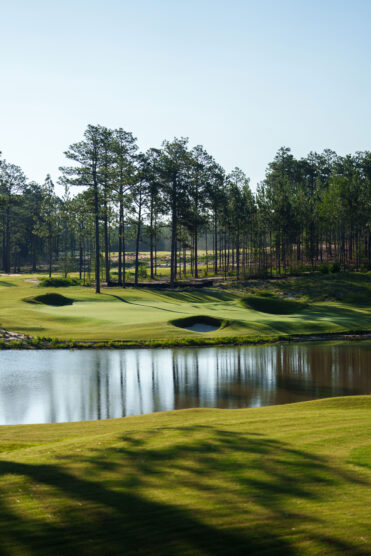
Pinehurst Number 10
A loop round the newest course at the famed North Carolina resort.
How do you stay at the top when everyone else is biting at your heels? Sometimes it’s best to stay the course—or if golf courses are your business, build another one. For Pinehurst Resort in North Carolina, the latest adaptation is the 10th course under its umbrella. Sandmines, as it is known, is geographically removed from the rest of the resort and outside the bubble of the main arena where hundreds gather to play every day and that orders of magnitude more have seen on TV when the U.S. Open comes to town.
The site, as the name suggests, was home to an old sand quarry and a subsequent golf course development that was left fallow. After Pinehurst acquired the property, it enlisted architect Tom Doak to sculpt the new routing. While the scenery and the fauna are pure Carolina Sandhills, what sets No. 10 apart is the dramatic elevation changes that the land provides.

Driving up to it this past summer gave a small glimpse into the site’s past life. Although the course is complete and open for play, the construction of the future club house and pro shop remains ongoing, and the machines and cabins lingering around the first tee only added to the feeling that you are getting to play a brand new course.
Pinehurst doesn’t really need the draw of a new course to attract visitors, which maybe explains the slightly more risky design elements of No. 10. The resort’s preexisting popularity has afforded it the opportunity to provide golfers with something different to experience in a region already loaded with courses.

Holes one through seven toy with the dramatic but for the most part are fairly flat, with good bunkering to make you think off the tee. Particularly fun is the fourth hole, a drivable par 4 (provided you pick the right tees) that rewards a brave drive but can be equally punishing if you are errant with your tee ball. On the eighth, things start to flirt with the outlandish, as you strike a blind tee shot over a huge mound onto a wild fairway. The approach is just as exhilarating, and it seems to have more in common with the links courses of Ireland’s west coast than the other offerings at Pinehurst.
So begins what a caddie in our group referred to as “the real course.” The ninth is a bruising uphill dogleg left, and if you are carrying your bag like I was, a good place to stop for a water break. The tenth is a monster par 5 that can stretch to over 600 yards and benefits from the elusive straight ball off the tee. The length contracts at the par 3 eleventh, but the difficulty lingers, tee shot leaking left is essentially dead, and the bailout to the right leaves a touchy bunker shot to save par.

Some holes may require a few seasons of play to be fully realized. Hole 14 has a green, sloped from left to right, that will be difficult if not impossible for many amateurs to hold from any real distance. Additionally, the opening stretch is not as memorable as the back, and while a members club can afford this luxury as the same golfers repeat the holes and learn the more detailed nuances, given that Number 10 caters only to visitors, and if not booked as part of a package can cost hundreds of dollars, this may be a bugbear for some.

Another standout on the back nine is the 17th, a par 3 played over water with plenty of undulation on the greens that can turn a slightly wayward iron shot into an all-time approach. It is a great encapsulation of the course’s strengths: as risky as you want it to be, easy on the eye, and a whole lot of fun.




